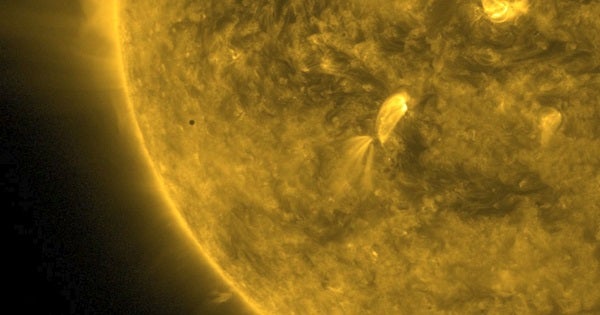On November 11, Mercury will pass directly between Earth and the Sun. The occurrence, called a transit, will attract the attention of many thousands of astronomers. As infrequent as a Mercury transit is (one happens 13 or 14 times a century) and as interesting as it is to witness, I still regard this one as a cosmic “consolation prize.” I’ve felt that way ever since June 5, 2012, the date of the last transit of Venus.
Transits of Venus are so rare, they make those of Mercury look like everyday occurrences. True, there were two Venus transits relatively recently, in 2004 and 2012, but the last one before those happened in 1882. And there will be no future Venus transit until 2117! Of course, on those two days of my life when a Venus transit was in the offing, clouds ruined the show. I’ve become so jaded that I now regard a transit of Mercury as a poor man’s Venus transit.
At least the weather cooperated for me during Mercury transits. My first was way back on the morning of November 10, 1973, when I was able to capture the last hour-plus of the event. A naïve novice, I tracked its progress with a 2.4-inch refractor and a 30x eyepiece fitted with (gasp!) a screw-in solar filter. Luckily, my observations, made at 15-minute intervals, were brief enough that the filter didn’t shatter due to the Sun’s concentrated heat. What impressed me most about the tiny planet’s transit was how black Mercury’s disk appeared compared to a typical sunspot, and how fast the planet seemed to move as it closed in on the Sun’s edge. My most recent success was during the Mercury transit that occurred on May 9, 2016. My viewing equipment for this one (a Hydrogen-alpha filtered solar scope) was far more sophisticated and certainly safer.
Because viewing a transit essentially involves observing the Sun, precautions must be taken to prevent damage to the eye and optical equipment. I’ve discussed safe solar observing here in the past (“Good Sun Behavior” in June 2005, “Solar Safety” in July 2009, and “Here Comes the Sun” in August 2015). You can access these articles on Astronomy.com. While there, you can also go to the Observing section, scroll to “Observe the Solar System,” and check out Michael Bakich’s tutorial, “How to Safely Observe the Sun.”
Not everyone will get a ringside seat to this upcoming Mercury transit. From much of western and central Canada, Hawaii, southeast Alaska, most of Mexico, and the western two-thirds of the continental U.S., the event will already be in progress at sunrise. Sunset will cut the transit short for those situated in Europe, the Middle East, and most of Africa. The entire transit is visible to observers in southeast Canada and southeast Mexico, the eastern third of the continental U.S., all of Central and South America, extreme Western Africa, and most of Antarctica. You’ll get less than the full show if you’re anywhere else.
How long will this transit last? From a geocentric (center of the Earth) viewpoint, the transit will run from 12:35:27 UT (7:35:27 A.M. EST) until 18:04:14 UT (1:04:14 P.M. EST) — a span of 5½ hours. A global visibility chart for the upcoming transit appears on page 50.
Truth be told, a transit of Mercury (or even Venus) pales in comparison to a transit of the Moon (better known as a solar eclipse). There is no sudden midday darkness or the visual spectacle of a blackened Sun surrounded by a pearly white corona that attracts mass media attention. Nope, all you’ll see is a tiny black dot making its way across the solar disk. But it’s the aforementioned rarity of the occurrence that makes it a can’t-miss event, especially if you’ve never witnessed a Mercury transit before. Consider also that the next two, on November 13, 2032, and November 7, 2039, won’t be visible from the U.S. and Canada. For us, the next Mercury transit will be on May 7, 2049, so don’t miss this month’s!
Questions, comments, or suggestions? Email me at gchaple@hotmail.com. I’ll be away next month, but I will return in January with my must-observe target list for 2020. Clear skies!










